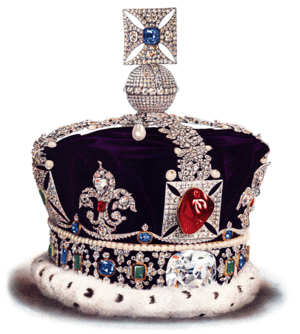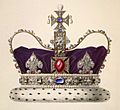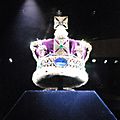Imperial State Crown facts for kids
Quick facts for kids Imperial State Crown |
|
|---|---|
 |
|
| Details | |
| Country | United Kingdom |
| Made | 1937 (current version) |
| Owner | Queen Elizabeth II in right of the Crown |
| Weight | 1.06 kg (2.3 lb) |
| Arches | Two |
| Material | Gold, silver, platinum |
| Cap | Velvet trimmed with ermine |
| Notable stones | Cullinan II, St Edward's Sapphire, Black Prince's Ruby, Stuart Sapphire |
The Imperial State Crown is one of the Crown Jewels of the United Kingdom and symbolises the sovereignty of the monarch. The crown has existed in several versions since the 15th century.
The modern version of the Imperial State Crown is of a design somewhat similar to that of St Edward's Crown, but shorter and encrusted with jewels: it includes a base of four crosses alternating with four fleurs-de-lis, above which are four half-arches surmounted by a cross. Inside is a purple velvet cap with an ermine border. The Imperial State Crown includes many precious gems, including 2,868 diamonds, 273 pearls, 17 sapphires, 11 emeralds, and 5 rubies.
The crown includes several famous jewels. The cross at the top is set with a stone known as St. Edward's Sapphire, a sapphire taken from the ring (or possibly coronet) of Edward the Confessor. The Black Prince's Ruby (actually a spinel) is set on the front cross pattée; the famous Cullinan II, or Lesser Star of Africa, is set on the front; and the back band contains the 104-carat (20.8 g) Stuart Sapphire. The crown also contains Queen Elizabeth’s Pearls.
Contents
Description
The Imperial State Crown is 31.5 cm (12.4 in) tall and weighs 1.06 kg (2.3 lb), and has four fleurs-de-lis and four crosses pattée, supporting two arches topped by a monde and cross pattée. Its purple velvet cap is trimmed with ermine. The frame is made of gold, silver and platinum, and decorated with 2,868 diamonds, 273 pearls, 17 sapphires, 11 emeralds, and 5 rubies.
Notable stones are St Edward's Sapphire on the top cross, reputedly taken from the ring of Edward the Confessor when he was re-interred at Westminster Abbey in 1163, and the Black Prince's Ruby (a large spinel) on the front cross. In 1909, the 104-carat (21 g) Stuart Sapphire, set in the front of the crown, was moved to the back and replaced by the 317-carat (63 g) Cullinan II. Below the monde hang four pearls, three of which are often said to have belonged to Queen Elizabeth I, but the association is almost certainly erroneous.
Usage
The crown is worn by the monarch on leaving Westminster Abbey at the end of his or her coronation. It is also worn or carried at the annual State Opening of Parliament, although in 1974 and 2017, when snap general elections were held, Queen Elizabeth II chose to wear a hat. Usually, the crown is taken to the Palace of Westminster under armed guard in its own carriage and placed in the Robing Room, where the Queen dons her robes and puts on the crown before giving her speech to Parliament. When not in use, the Imperial State Crown is on public display in the Jewel House at the Tower of London.
Images for kids
-
The front of George I's State Crown, 1714
-
Queen Victoria's crown made in 1838
-
George V wearing the crown in 1911
-
Elizabeth II after her coronation in 1953
See also
 In Spanish: Corona imperial del Estado para niños
In Spanish: Corona imperial del Estado para niños






